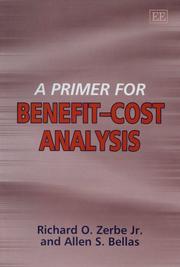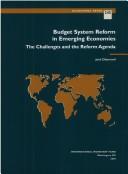| Listing 1 - 8 of 8 |
Sort by
|

ISBN: 9781847208019 9781843768975 1843768976 Year: 2006 Publisher: Cheltenham Edward Elgar
Abstract | Keywords | Export | Availability | Bookmark
 Loading...
Loading...Choose an application
- Reference Manager
- EndNote
- RefWorks (Direct export to RefWorks)
Social costs. Social benefits --- #SBIB:35H411 --- #SBIB:303H15 --- cost accounting --- financiële analyse --- Beleidscyclus: voorbereiding (inclusief planning) --- Methoden en technieken van de bestuurswetenschappen --- Cost effectiveness --- Costs, Industrial --- Expenditures, Public --- Appropriations and expenditures --- Government appropriations --- Government expenditures --- Government spending --- Public expenditures --- Public spending --- Spending, Government --- Costs of production --- Industrial costs --- Industries --- Production costs --- Benefit cost analysis --- Capital output ratios --- Cost benefit analysis --- Costs --- Finance, Public --- Public administration --- Government spending policy --- Cost --- Engineering economy --- Value analysis (Cost control)

ISBN: 1589064747 9781589064744 Year: 2006 Volume: 245 Publisher: Washington, DC : International Monetary Fund,
Abstract | Keywords | Export | Availability | Bookmark
 Loading...
Loading...Choose an application
- Reference Manager
- EndNote
- RefWorks (Direct export to RefWorks)
Public finance --- Organisation for Economic Co-operation and Development --- Budget process --- Program budgeting --- Expenditures, Public. --- Accrual basis accounting --- budget --- begrotingsbeleid --- management --- Expenditures, Public --- 336.3091724 --- 330.05 --- Appropriations and expenditures --- Government appropriations --- Government expenditures --- Government spending --- Public expenditures --- Public spending --- Spending, Government --- Finance, Public --- Public administration --- Government spending policy --- Accrual accounting --- Accounting --- Cash basis accounting --- Performance budget --- Planning-programming-budgeting --- Budget --- begroting --- politique budgetaire --- Budget process - OECD countries. --- Budget process - Developing countries. --- Program budgeting - OECD countries. --- Program budgeting - Developing countries. --- Accrual basis accounting - OECD countries. --- Accrual basis accounting - Developing countries.
Book
ISBN: 1451864922 146235887X 1451909454 9786613830074 1452722897 1283517620 Year: 2006 Publisher: Washington, D.C. : International Monetary Fund,
Abstract | Keywords | Export | Availability | Bookmark
 Loading...
Loading...Choose an application
- Reference Manager
- EndNote
- RefWorks (Direct export to RefWorks)
Women are disadvantaged relative to men, according to key economic, social, and political measures of equality, but in many areas, such as education, differences are narrowing. The concept of externalities underlies the arguments for including gender considerations in budget programs and policies. Other arguments have a weaker economic basis but may be more socially or politically compelling. The experience to date with "gender budgeting," which entails looking at gender issues comprehensively within the budget, has been mixed. To become more useful, gender budgeting should be integrated into budget processes in a way that generates tangible improvements in policy outcomes. The International Monetary Fund should encourage fiscal authorities to take into account the external benefits of reducing gender inequalities and to remove from fiscal legislation any arbitrary discrimination against women.
Electronic books. -- local. --- Equality. --- Expenditures, Public. --- Sex discrimination. --- Discrimination, Sexual --- Gender discrimination --- Sexual discrimination --- Appropriations and expenditures --- Government appropriations --- Government expenditures --- Government spending --- Public expenditures --- Public spending --- Spending, Government --- Egalitarianism --- Inequality --- Social equality --- Social inequality --- Discrimination --- Sexism --- Gender mainstreaming --- Finance, Public --- Public administration --- Government spending policy --- Political science --- Sociology --- Democracy --- Liberty --- Budgeting --- Women''s Studies' --- Gender Studies --- Economics of Gender --- Non-labor Discrimination --- National Budget --- Budget Systems --- Gender studies, gender groups --- Gender studies --- women & girls --- Social discrimination & equal treatment --- Budgeting & financial management --- Women --- Gender budgeting --- Gender inequality --- Budget planning and preparation --- Gender --- Public financial management (PFM) --- Sex role --- Sex discrimination --- Budget --- India --- Women & girls --- Women's Studies
Book
ISBN: 1451864647 1462388140 1451993234 9786613824592 1451988346 1283512149 Year: 2006 Publisher: Washington, D.C. : International Monetary Fund,
Abstract | Keywords | Export | Availability | Bookmark
 Loading...
Loading...Choose an application
- Reference Manager
- EndNote
- RefWorks (Direct export to RefWorks)
A well-functioning public expenditure management (PEM) system is considered a critical pillar of government efficiency, on par with a low-distortion tax system and efficient tax administration. The paper discusses PEM systems in developing countries using an analytical framework based on principal-agent theory. This simple model can be applied to various PEM systems, and allows for comparisons between institutional settings. To illustrate this, we analyze the benefits derived from the use by the Ministry of Finance (MoF) of two control instruments; ex post audits and ex ante controls, and assess their value in terms of their ability to deter cheating. We derive a set of possible "control regimes" which can be used by the MoF. Although we illustrate the use of the model using developing countries, it is also relevant to developed economies.
Electronic books. -- local. --- Expenditures, Public -- Developing countries. --- Government spending policy -- Management -- Developing countries. --- Political Science --- Law, Politics & Government --- Public Finance --- Government spending policy --- Expenditures, Public --- Management --- Appropriations and expenditures --- Government appropriations --- Government expenditures --- Government spending --- Public expenditures --- Public spending --- Spending, Government --- Public spending policy --- Spending policy, Government --- Government policy --- Finance, Public --- Public administration --- Economic policy --- Full employment policies --- Unfunded mandates --- Taxation --- Auditing --- Taxation, Subsidies, and Revenue: General --- National Government Expenditures and Related Policies: General --- Public Administration --- Public Sector Accounting and Audits --- Management accounting & bookkeeping --- Public finance & taxation --- Expenditure --- External audit --- Internal controls --- Tax incentives --- Revenue --- France
Book
ISBN: 1451864256 1462331645 1451985061 9786613825858 1452790507 1283513404 Year: 2006 Publisher: Washington, D.C. : International Monetary Fund,
Abstract | Keywords | Export | Availability | Bookmark
 Loading...
Loading...Choose an application
- Reference Manager
- EndNote
- RefWorks (Direct export to RefWorks)
This paper continues the study of optimal fiscal policy in a growing economy by exploring a case in which the government simultaneously provides three main categories of expenditures with distortionary tax finance: public production services, public consumption services, and state-contingent redistributive transfers. The paper shows that in a general equilibrium model with given exogenous fiscal policy, a nonlinear relation exists between the suboptimal longrun growth rate in a competitive economy and distortionary tax rates. When fiscal policy is endogenously chosen at a social optimum, the relation between the rate of growth and tax rates is always negative. These two conclusions suggest that the interaction between fiscal policy and growth may be complicated enough that it cannot be captured in a simple linear model using an aggregate measure of fiscal policy. The sources of nonlinearity include expectation and coordination of fiscal policy, impluse response of government policies, and the presence of positive externality due to government spending.
Electronic books. -- local. --- Expenditures, Public -- Econometric models. --- Fiscal policy -- Econometric models. --- Taxation -- Econometric models. --- Political Science --- Law, Politics & Government --- Public Finance --- Expenditures, Public --- Fiscal policy --- Taxation --- Econometric models. --- Tax policy --- Appropriations and expenditures --- Government appropriations --- Government expenditures --- Government spending --- Public expenditures --- Public spending --- Spending, Government --- Government policy --- Economic policy --- Finance, Public --- Public administration --- Government spending policy --- Macroeconomics --- National Government Expenditures and Related Policies: General --- Fiscal Policy --- Aggregate Factor Income Distribution --- Taxation, Subsidies, and Revenue: General --- Public finance & taxation --- Expenditure --- Revenue administration --- Income --- Income inequality --- Revenue --- Income distribution --- Denmark

ISBN: 9781593115357 1593115350 9781593115364 1593115369 Year: 2006 Publisher: Greenwich IAP
Abstract | Keywords | Export | Availability | Bookmark
 Loading...
Loading...Choose an application
- Reference Manager
- EndNote
- RefWorks (Direct export to RefWorks)
#SBIB:35H220 --- Financieel management bij de overheid: algemene werken --- Administrative agencies --- Expenditures, Public --- Finance, Public --- Government trading --- State trading --- Commerce --- Commercial policy --- Government business enterprises --- Cameralistics --- Public finance --- Currency question --- Appropriations and expenditures --- Government appropriations --- Government expenditures --- Government spending --- Public expenditures --- Public spending --- Spending, Government --- Public administration --- Government spending policy --- Agencies, Administrative --- Executive agencies --- Government agencies --- Regulatory agencies --- Administrative law --- Law and legislation --- New Zealand --- Nya Zeeland --- Aotearoa --- Novai︠a︡ Zelandii︠a︡ --- Nowa Zelandia --- Nouvelle-Zélande --- Nu Ziland --- Niu-hsi-lan --- Novzelando --- Nyū Jīrando --- Neu-Seeland --- Nieu-Seeland --- Новая Зеландыя --- Novai︠a︡ Zelandyi︠a︡ --- Novi Zeland --- Нова Зеландия --- Nova Zelandii︠a︡ --- Nova Zelanda --- Nový Zéland --- Neuseeland --- Seland Newydd --- Uus-Meremaa --- Νέα Ζηλανδία --- Nea Zēlandia --- Nueva Zelanda --- Nueva Zelandia --- Nov-Zelando --- Zeelanda Berria --- Nýsæland --- Nýja-Sjáland --- Nuova Zelanda --- ניו זילנד --- Nyu Ziland --- N.Z. (New Zealand) --- NZ --- ニュージーランド --- Nyūjīrando --- Appropriations and expenditures. --- Public finances
Book
ISBN: 1451864078 1462315496 1452702489 9786613824820 1451991371 1283512378 Year: 2006 Publisher: Washington, D.C. : International Monetary Fund,
Abstract | Keywords | Export | Availability | Bookmark
 Loading...
Loading...Choose an application
- Reference Manager
- EndNote
- RefWorks (Direct export to RefWorks)
This paper analyzes the empirical relationship between fiscal policy and the trade account. Research prior to this paper did not consider that the components of private and public demand in the import demand equation exhibit different elasticities. Using pooled mean group estimation for annual panel data of the G-7 countries for the years 1970 through 2002, we provide empirical evidence that the composition of overall demand-i.e., the distribution among public demand, private demand, and export demand-has an impact on the magnitude of the trade account deficit.
Balance of trade -- Econometric models. --- Demand (Economic theory) -- Econometric models. --- Electronic books. -- local. --- Expenditures, Public -- Econometric models. --- Fiscal policy -- Econometric models. --- Imports -- Econometric models. --- Commerce --- Business & Economics --- Commerce - General --- Balance of trade --- Demand (Economic theory) --- Expenditures, Public --- Fiscal policy --- Imports --- Econometric models. --- Tax policy --- Taxation --- Appropriations and expenditures --- Government appropriations --- Government expenditures --- Government spending --- Public expenditures --- Public spending --- Spending, Government --- Deficits, Trade --- Trade, Balance of --- Trade balance --- Trade deficits --- Trade surpluses --- Surpluses, Trade --- Government policy --- International trade --- Economic policy --- Finance, Public --- Public administration --- Government spending policy --- Supply and demand --- Production (Economic theory) --- Balance of payments --- Mercantile system --- Payment --- Exports and Imports --- Investments: General --- Macroeconomics --- Public Finance --- Trade: General --- National Government Expenditures and Related Policies: General --- Macroeconomics: Consumption --- Saving --- Wealth --- Investment --- Capital --- Intangible Capital --- Capacity --- International economics --- Public finance & taxation --- Expenditure --- Private consumption --- Private investment --- Exports --- Consumption --- Economics --- Saving and investment --- Japan
Book
ISBN: 1462370365 1452789681 Year: 2006 Publisher: Washington, D.C. : International Monetary Fund,
Abstract | Keywords | Export | Availability | Bookmark
 Loading...
Loading...Choose an application
- Reference Manager
- EndNote
- RefWorks (Direct export to RefWorks)
With increasing frequency, the IMF has assisted middle-income countries, especially emerging economies, in adopting the types of budget reforms that have been introduced in many Organization for Economic Cooperation and Development (OECD) countries - reforms that emphasize performance and results achieved from the use of public resources. This paper examines the experience of OECD countries in introducing such reforms and assesses whether the same reform strategy be applied to non-OECD countries. It examines how emerging economies should begin such reforms, and how they should be sequenced thereafter. Based on a thorough review of the technical assistance provided by the IMF's Fiscal Affairs Department (FAD) to middle-income countries, this paper will be useful to policymakers and administrators in emerging economies who are contemplating such reforms.
Budget process --- Program budgeting --- Expenditures, Public. --- Accrual basis accounting --- Accrual accounting --- Accounting --- Cash basis accounting --- Appropriations and expenditures --- Government appropriations --- Government expenditures --- Government spending --- Public expenditures --- Public spending --- Spending, Government --- Finance, Public --- Public administration --- Government spending policy --- Performance budget --- Planning-programming-budgeting --- Budget --- Budgeting --- Macroeconomics --- Money and Monetary Policy --- Public Finance --- National Budget --- Budget Systems --- Public Administration --- Public Sector Accounting and Audits --- National Budget, Deficit, and Debt: General --- National Government Expenditures and Related Policies: General --- Taxation, Subsidies, and Revenue: General --- Monetary Systems --- Standards --- Regimes --- Government and the Monetary System --- Payment Systems --- Budgeting & financial management --- Public finance accounting --- Public finance & taxation --- Civil service & public sector --- Financial reporting, financial statements --- Budget planning and preparation --- Fiscal accounting and reporting --- Performance-based budgeting --- Budget execution and treasury management --- Public financial management (PFM) --- Revenue --- Expenditures, Public --- Money --- New Zealand
| Listing 1 - 8 of 8 |
Sort by
|

 Search
Search Feedback
Feedback About UniCat
About UniCat  Help
Help News
News